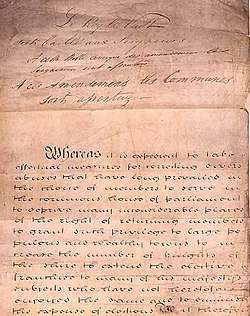La Reyne le veult
La Reyne le veult ("The Queen wills it") or Le Roy le veult ("The King wills it") is a Norman French phrase used in the Parliament of the United Kingdom to signify that a public bill (including a private member's bill) has received royal assent from the monarch of the United Kingdom. It is a legacy of the time prior to 1488 when parliamentary and judicial business was conducted in French, the language of the educated classes dating to the Norman Conquest of 1066. It is one of a small number of Norman French phrases that continue to be used in the course of parliamentary procedure.

Variations of the English and modern French translations of the phrase are also used in the royal assent ceremony used in the Canadian Parliament. Norman French is not used.[1]
Usage
The phrase is used to signify that the monarch has granted his or her royal assent to a bill in order to make it become law. It is used by the Clerk of the Parliaments in the House of Lords. It is only used after the Lord Chancellor, accompanied by the Lords Commissioners, has read out the letters patent for the bill. The Clerk of the Crown then reads out the short title of the bill and the Clerk of the Parliaments responds by saying the phrase towards the House of Commons at the bar of the House for each bill.[2][3] The phrase is also written on the paper of the bill to show that the monarch granted royal assent to the bill.[4]
Should royal assent be refused, the expression La Reyne/Le Roy s'avisera, "The Queen/King will be advised" (i.e., will take the bill under advisement), a paraphrase of the Law Latin euphemism Regina/Rex consideret ("The Queen/King will consider [the matter]"), would be used, though no British monarch has denied royal assent since Queen Anne withheld it from the Scottish Militia Bill in 1708.[5]
For a supply bill, an alternative phrase is used; La Reyne/Le Roy remercie ses bons sujets, accepte leur benevolence, et ainsi le veult ("The Queen/King thanks her/his good subjects, accepts their bounty, and wills it so").[6] For a personal bill, the phrase Soit fait comme il est désiré ("Let it be done as it is desired") is used.
History
The practice of giving royal assent originated in the early days of Parliament to signify that the king intended for something to be made law.[7] Norman French came to be used as the standard language of the educated classes and of the law, though Latin continued to be used alongside it.[8] The work of the Parliament of England was conducted entirely in French until the latter part of Edward III's reign (1327–1377) and English was only rarely used before the reign of Henry VI (1422–1461, 1470–1471). Royal assent was occasionally given in English, though more usually in French.[9] The practice of recording parliamentary statutes in French or Latin ceased by 1488 and statutes have been published in English ever since.[8]
The phrase Le Roy le veult was also used in the Parliament of Ireland (13th century – 1800).[10]
During the period of the Protectorate, when the Lord Protector (Oliver Cromwell and later his son Richard Cromwell) governed the country, assent was given in English. The old practice of giving assent in Norman French was resumed following the English Restoration in 1660 and has continued ever since. There has only been one attempt to abolish it, when the House of Lords passed a bill in 1706 "for abolishing the use of the French tongue in all proceedings in Parliament and courts of justice". The bill failed to pass the House of Commons. Although the use of French in courts was abolished in 1731, Parliamentary practice was unaffected.[9]
References
- CBC News (2018-12-13), Gov. Gen. Julie Payette presides over last Royal Assent ceremony, retrieved 2019-07-24
- "Interview with the former Clerk of the Parliaments-part two". Parliament of the United Kingdom. 2007-11-03. Retrieved 2013-03-02.
- The Committee Office (2007-02-19). "Royal Assent By Commission". Parliament of the United Kingdom. Retrieved 2013-03-02.
- "Documenting Democracy". Parliament of Australia. Retrieved 2013-03-02.
- Erskine May, pp. 372–3
- Bennion, Francis (November 1981). "Modern Royal Assent Procedure at Westminster". Statute Law Review. 3 (2): 133–147.
- "La Reyne le Veult The making and keeping of Acts at Westminster" (PDF). House of Lords. Retrieved 2013-03-02.
- Crabbe, V.C.R.A.C (2012). Understanding Statutes. London: Routledge. p. 11. ISBN 9781135352677.
- Erskine May, Thomas (1844). Erskine May: Parliamentary Practice. London: Charles Knight & Co. p. 373. OCLC 645178915.
- Howard, Gorges Edmond (23 December 1776). A Treatise of the Exchequer and Revenue of Ireland. J.A. Husband. p. 236 – via Internet Archive.
le Roy Le veult ireland.